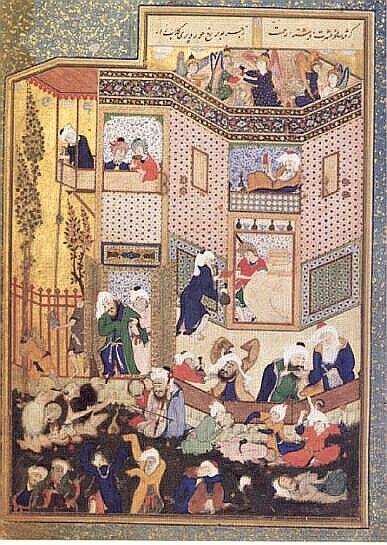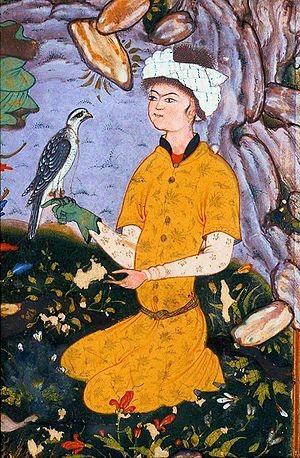Art miniature – a peculiar phenomenon of oriental painting
A miniature of the East … A unique phenomenon in the history of world art, attracting with its special vision of the beautiful world, absorbing the artistic experience of many generations and people of the Middle and Near East, Central Asia. Researchers see the origins of miniature painting in fabulously mythological images of books, a monumental “wall painting”. Modern artists draw inspiration from miniature works. For historians and ethnographers, these are invaluable documents of past eras, evidence of the cultural and material way of life of people in the Middle Ages.

Miniature as a peculiar phenomenon of oriental painting is inextricably linked with the development of medieval literature.
The miniature has its own, developed through centuries of evolution, expressive language of painting.
The oriental master conditionally conveys the perspective and the spatial plans connected with it, as if from a bird’s flight, which allows showing multi-figure compositions on a small plane, including simultaneously the architectural decor of the exterior and interior that is, creating a whole microcosm.

In its evolution, oriental miniature has come a long and difficult way from modest, restrained forms of 12–13 centuries to the richest pictorial traditions of miniature painting of 15–17 centuries. During these periods, the main centers of miniature art were identified: Shi-Raz, Tabriz, Herat, Central Asian, Isfahan schools, miniature paintings of the Great Mughals (state in northern India).

Versatility, festive decorativeness with jewelry accuracy of the image of details, harmony of colors and rhythm give way to a more lively, direct reproduction of life. The results of the analysis of the evolution of miniature painting in Central Asia give reason to say that the miniature of the 15-17 centuries allows us to realize the aesthetic ideals of the peoples of Central Asia of that period, their vision of the surrounding reality. And most importantly, they provide the basis for their creative use in teaching modern miniaturists to familiarize themselves with the “secrets” of ancient pictorial craft, and to creatively use miniature techniques in the most diverse branches of fine and decorative arts.
The technology of miniature painting of the East is a complex, multifaceted art; his recipes and methods were handed down from generation to generation, carefully guarded. The masters of antiquity attached great importance to the quality of art materials, rightly believing that a lot depends on this. Based on the accumulated techniques and visual means, the masters of the brush of the medieval East created a unique style of synthesis of conditional and real style that perfectly matches the poetics and prose of classical literature and historical chronicles of the East.

Today, miniaturists also try to preserve the special slowness of antiquity, the calm dignity of masters – artists of past centuries, who are not inclined to insult their work in a hurry and who portray the world in a concentrated and reverent manner. And when we, meeting the will of miniature masters with a new compositional “structure”, compare the characters they depict with the very objects on which they are applied, this graphically abstract rhythmic “liveliness” of the image and the melodiousness of the local color spots help us more clearly feel the stylistic completeness and freedom of their works.
The rhythm clearly acts as the formative element of the style, and the connections between objects enhance the impact of these objects on our perception, saturating the environment with “spiritual” tension. A certain system of techniques is developed that expresses and consolidates the taste of the people, their ideas about life values, beauty – this is a socio-artistic basis, the environment that forms the artist’s personality. Hence the high significance of the technique, the spiritual content of the form in the works of organic style.

The works of Uzbek miniature painters are an example of the addition of stylistic unity with a developed “personal”, individual beginning, which explains the emotional richness and integrity of their works. It is characteristic that stylization under “pseudo-folk art” is almost never found here, for the lessons of truly folk art have included up to the blood of the contemporary artistic thinking of masters. A kind of new, unprecedented type of contemporary art arises, where the emotional-psychological warehouse of the personality-people finds, as in music, a direct expression in the very structure, the complex-harmonious warehouse of works.
Art Miniature in the modern world
Art miniature is a special kind of fine art. Since ancient times, miniatures have been considered part of manuscript books and manuscripts in the East, illustrating texts. Small bright colorful pictures, varnished, adorned the interiors of palaces and rich houses.
The ancestor of the Uzbek miniature is Kamoliddin Behzod (1450-1536), whose works are considered classic and are stored in many museums around the world. A museum of miniatures named after him.
Today, art miniature is an independent type of Uzbek fine art. Miniature painting in Uzbekistan is represented by various types: a miniature on paper, on leather, on wood, on fabric, on canvas, on papier-mâché boxes.

It is interesting to see how, bending over the table, the master masterfully applies fine painting on the covers of manuscript books, tables made of precious wood, pencil cases, caskets. The pattern is applied with brushes on the ground, which is made of gold or bronze powder with the addition of cherry or apricot glue.

Plots for drawings are taken from folk art, often from the works of great Uzbek poets – Navoi, Jami, Furkat, Nizami. Also, many plots are taken from historical chronicles, scenes of battles, hunting, feasts. Another feature of the miniature is the minimum of details and the plot should be in the palm of your hand without using the technique of perspective, as in classical paintings. In recent years, strict geometric ornaments, floral patterns, flowers have been popular.
Uzbek Miniature is a great original gift and souvenir.

